What is a cord of firewood?
A cord is a tightly packed stack of firewood. It is the standard measurement for firewood, and when you order wood, your supplier will charge you by the cord (or fraction of a cord).
Not all cords are created equal, though; cords can come in different sizes, packing styles and include various types of wood.
This 2 minute move could knock $500/year off your car insurance in 2025
OfficialCarInsurance.com lets you compare quotes from trusted brands, such as Progressive, Allstate and GEICO to make sure you're getting the best deal.
You can switch to a more affordable auto insurance option in 2 minutes by providing some information about yourself and your vehicle and choosing from their tailor-made results. Find offers as low as $29 a month.
Find the best rate for youHow much is a cord of wood?
A standard cord of wood is 128 cubic feet, and typically comes in a stack measuring 4 feet tall, 4 feet deep and 8 feet wide.
Exact measurements may vary by region and seller. Not every supplier will cut their wood pieces to the same length and stack them in the same manner, which results in some variations in size.
That said, these variations make it tricky to price shop.
If Supplier A sells a cord of tightly packed wood measuring 3.75 feet tall, 4 feet deep, 8 feet wide for $140, and Supplier B sells a loosely packed cord measuring 4.25 feet tall, 4 feet deep, 8 feet wide for $180, which is the better deal?
Good luck figuring that out without a calculator. But it gets even more confusing.
3 types of cords
It turns out there are three types of cords. So when you say, “I’d like to buy a cord of wood,” you should always specify which type.
Full cord: This is the standard size measuring 4 foot tall, 4 foot deep, 8 foot wide. When you order a cord, most people will assume you mean a full cord. But it’s better to be crystal clear.
Face cord: This is the smallest type of cord, measuring 4 feet tall, 8 feet wide, 16 inches deep (the depth of one piece of wood). This ends up being roughly one-third the amount of wood as a full cord.
Sheldon cord: The size of a Sheldon cord varies by region, but it is always bigger than a full cord.
The takeaway here is: Always ask before buying.
Just because one supplier offers a lower price per cord doesn’t necessarily mean it’s a better deal.
How much does a cord of wood cost?
The average cost of a cord of wood is $300, according to HomeAdvisor, but the actual cost varies significantly by region, from the low end of $150 up to $700.
You may even see both extremes within the same state.
Factors affecting how much a cord of wood costs
Apart from geographic location, several other factors can affect the cost of a cord of wood, such as:
- Type of wood: Hardwoods such as ash, maple, black birch, oak and walnut are more expensive than softwoods. This is because they burn hotter and for a longer time.
- Season: Prices increase in the winter, so it’s a good idea to stock up beforehand.
- Delivery: Some prices include delivery, while other suppliers charge based on distance.
- Convenience: To save time, it might be worth paying extra for pre-stacked cords cut into the exact length you need.
- Condition: Expect wet, dirty wood to cost less than dry, clean wood.
Since cord prices vary so much, the best way to determine the going rate in your area is to call a handful of suppliers. Just don’t forget to ask about the type of wood, delivery, condition, etc.
Kiss your credit card debt goodbye
Millions of Americans are struggling to crawl out of debt in the face of record-high interest rates. A personal loan offers lower interest rates and fixed payments, making it a smart choice to consolidate high-interest credit card debt. It helps save money, simplifies payments, and accelerates debt payoff. Credible is a free online service that shows you the best lending options to pay off your credit card debt fast — and save a ton in interest.
Explore better ratesHow to store a cord of firewood
Once you’ve settled on a supplier and ordered your first cord, what’s the best way to store it?
When your firewood arrives, your first step is to cut it into burnable pieces (if it isn’t already pre-cut). This will not only make the wood easier to store, but you’ll also save yourself the hassle of hauling out your ax every time you need wood to burn.
If you’re using a wood stove, it’s helpful to know its interior dimensions so you can cut your wood to size.
Once you have your burnable pieces, you’ll need to decide where to store your stacks. Ideally, this will be a dry area with good airflow. To help keep the wood dry, use a pallet, bricks or other logs to keep it off the ground.
At this point, you may be tempted to throw everything into a pile as fast as possible. But if you’re clever, you’ll stack strategically.
That means arranging your stack so that the wettest wood is on the bottom. That way, when you need a piece of dry wood, you can simply take it off the top. And by the time you get to the bottom of the pile, the wet wood will be dry.
It’s also a good idea to stack old wood toward the top so you’ll have a chance to burn it before it rots. Lastly, if you need to stack in multiple rows, make sure to leave space between each row for air circulation.
Once you finish stacking, cover the top rows with a tarp to protect the dry wood from the rain, but leave the bottom wet rows exposed. This will allow the air to dry them faster.
And there you have it — you are now a wood-stacking expert. To make the process even easier, you can buy indoor and outdoor racks designed for storing firewood.
Speaking of which, if you decide to store some of your wood indoors, it’s best to bring inside only what you need for the day. If you stockpile firewood inside, you may run into problems with pests, dirt, pollen and moisture in your home.
As you can see, there is quite a bit to consider when buying a cord of firewood. But by taking the time to compare all the variables and find the best supplier, you’ll save a lot of money over the long run (especially if you’re using wood as your primary heating source).
More: Heat pump tax credits still available in 2023
The richest 1% use an advisor. Do you?
Wealthy people know that having money is not the same as being good with money. Advisor.com can help you shape your financial future and connect with expert guidance . A trusted advisor helps you make smart choices about investments, retirement savings, and tax planning.
Try it now




